Editor’s Note: In the long long ago of early April, before at least two entire other controversies took the internet by storm, Pepsi released their now-infamous ad starring Kendall Jenner. Shortly after Pepsi pulled the ad, our own Pete Fenzel answered the question “Does having Kendall Jenner in this ad make it worse?” with a resounding “No.”
Even though the hot take-industrial complex has moved on to other topics, the conversation continued here at Overthinking It, both in the comments for the original post and in our own discussions amongst our team of writers.
Ben Adams picks things back up with a counterpoint to Pete’s argument…
At the outset I will grant that if the goal of this ad is “get people to talk about Pepsi,” then yes, it succeeded. No such thing as bad publicity and all that. If we’re just asking the cynical question “Was this ad effective at selling Pepsi?” then the jury is probably still out.
But even in the unlikely event that the ad ended up selling a ton of Pepsi, that doesn’t mean that the ad isn’t terrible in two important ways.
Why This Ad is Terrible in General
This ad is about a protest. Let’s make that clear from the start: if you just want a bunch of young pretty people doing crazy stuff, it’s called a flash mob, and you don’t make signs for those, and the police don’t generally get involved. Ditto farmers markets, street fairs, and fun runs.
More to the point, whatever it is they are protesting must be controversial in some way — if you have a bunch of people walking down a city street for a cause that everyone can agree on, it’s called a parade.
No, this ad is about a protest of a group of young people against some sort of political authority or agenda.
Which is why the anodyne nature of the protest just sucks the air out of everything. Pepsi is trying desperately to have its cake and eat it too: instead of just picking a side and sticking with it, Pepsi tried to come up with the most generic and meaningless signs and messages that they could to avoid pissing anyone off.
And even then they failed! Because this protest is necessarily and undeniably a progressive one. Though the peace sign has lost its punch, it’s not just some generic “get along” sign — it means destruction of the war machine, ending overseas conflicts, etc. So even though Pepsi DESPERATELY wished to avoid taking sides, that cat is officially out of the bag.
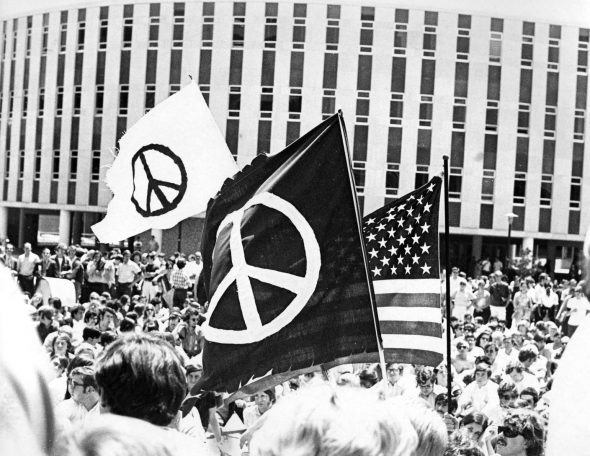
Leaving that aside, there’s no way to have a protest that prominently features a confrontation (albeit a peaceful one) between the protesters and police in 2017 without evoking a very specific set of political values. Aside from possibly immigration, the discussion around policing, mass incarceration, and the Black Lives Matter movement is probably the most salient political cleavage in America today.
Indeed, you can’t understand this commercial without confronting its treatment of the police and the interaction between protesters and the police head on. The police are crucial to understanding why this commercial is utterly unsalvageable.
When Kendall Jenner approaches the police officer to offer him a Pepsi, it’s meant to evoke a spirit of bravery. Those police officers are the Enemy, and by entering the no man’s land between protesters and police, she’s putting herself at risk. But then, surprise — the police like Pepsi too! See guys, we really have so much in common!
So right away you’ve got a problem with the commercial’s central message: “See, all these two opposing sides needed was to share in their common humanity, as symbolized by their love of a particular brand of sugar water.”
But that’s not the problem! It’s not even close to the problem! The confrontations between political protesters and police that have spent a solid year or two at the top of the news cycle were not about misunderstandings — they were about deep-rooted historical and economic struggles.
Why Does the Inclusion of Kendall Jenner Make the Ad Worse?
First off, I have no beef with the Kardashian/Jenner in question, and think the whole idea of them not being talented/skilled/deserving of fame/whatever is sort of beside the point. I actually think that the “famous for being famous” issue is, at most, ancillary to what is going on with this ad — the commercial would be every bit as bad if you inserted your favorite Academy Award winning actress into this ad.
No, the inclusion of a famous person here is wrong because it perpetuates a particularly nasty narrative about the nature of these sorts of political movements and moments. The combination of the photographer and the freeze-frame shot of Kendall bravely approaching the police line with a peace offering is clearly intending to evoke a certain strain of famous protest photographs. The presentation of the peace offering is a reference to the famous “Flower Power” photo:
However,visually, the commercial has a lot more in common with this image from the BLM protests in Baton Rouge:
But by having a beautiful celebrity, all the power and drama of these moments is sapped completely dry. Importantly, even in the world of the commercial, the person presenting the Pepsi peace offering is a famous person. It’s not Kendall Jenner playing some random protester (who just happens to look like a fashion model). No, this commercial is about Kendall Jenner qua Kendall Jenner.
The power of these photographs comes from the bravery of the individual confronting the power of the State: facing gun barrels or riot cops is, for the ordinary citizen, a scary proposition.
But if you’re a supermodel, that confrontation is substantially less dangerous! Guess what: the police aren’t going to open a can of tear gas when Kendall Jenner and the PROFESSIONAL PHOTOGRAPHERS that are accompanying her on her commercial shoot are present. T’wasn’t Pepsi that stayed the police’s hand — it was her fame.
Instead of being a people’s protest, this commercial looks like an ode to the times when some self-involved celebrity would go to a country ruled by a dictator and report back “Everything looked fine to me! Not a political prisoner in sight!” Try that as an investigative reporter or human rights activist with a blog and see how long your thumbs stay unscrewed.
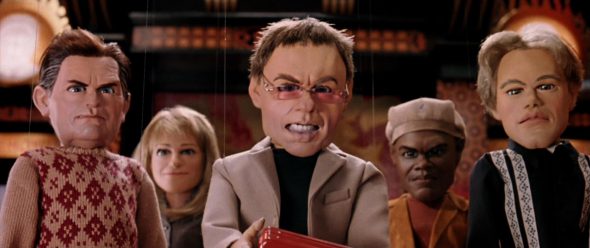
It’s not just that the commercial is awful because it elevates the status of a celebrity over the rank and file protesters for no particular reason. Her celebrity actually makes here the LEAST qualified person at the protest to make a bold stand against the State.
Stack on top of that the other implied message of the ad: the kids in the street have no idea what they’re protesting. The police presence links the protests inextricably with modern day political dissent and the Black Lives Matter movement. But the message of the protest as shown in the world of the commercial is utterly without meaningful content. It plays into the narrative that political protest is just a bunch of kids with nothing better to do.
More to the point, the commercial argues that protesters are really just following the political lead of whatever celebrity is at hand. This is quite literal in the ad: our Jenner didn’t even appear to be aware that the protest was occurring until it was already in full swing. But the Youths are so directionless that they will mindlessly follow any famous face.
Right or wrong, protests (a) take organization and (b) have an actual political agenda. People don’t just wake up one day and start dancing in the street with signs! Most street protests are organized weeks or months in advance, with permits, buses, signs, equipment, and grassroots organizers.
Even the most spontaneous and lawless protests take, at a minimum, a large group of dedicated people to organize it — where are we going to meet, when are we going to meet there, and where are we going to go when we all get there. And then someone has to buy poster board and magic markers!
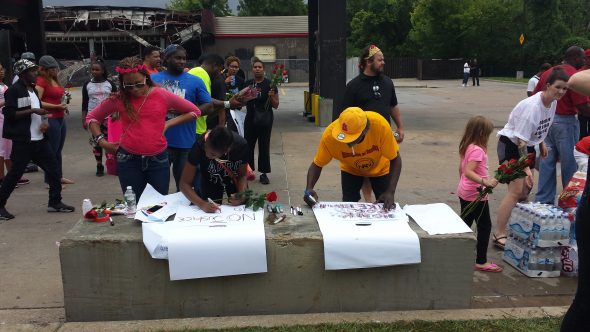
This commercial takes all of that effort and boils it down to: “Protests are a great way for the kids to unwind and break dance, but they don’t really mean anything. The protesters don’t even know what their protesting! Even if they did, all it takes to resolve our differences is to bond over our mutual love of attractive celebrities and consumer goods.”
As to Pete’s original point about the target market for this ad, I think Pepsi tries to have it both ways and ends up getting hit by traffic in both directions: it’s too obviously Pro-Black-Lives-Matter to sell to conservatives, and it’s too anodyne and wishy-washy to appeal to actual progressives.
That said, I think Pete is right about the sort of people that Pepsi is targeting with this ad. Pepsi was hoping to appeal to young people who want it to appear that they have the appropriately progressive politics, but will never do anything that might make them a) look unattractive or b) force them to take any actual stand on an issue of consequence. It’s an Instagram photo from the red carpet at a $500-a-plate charity gala intended to solve Third World hunger.
Where it fails is in the complete and utter ham-fistedness in execution. It’s basically a 2 minute version of that Goop post about living on food stamps, except it’s about Ferguson. That is not a great look.
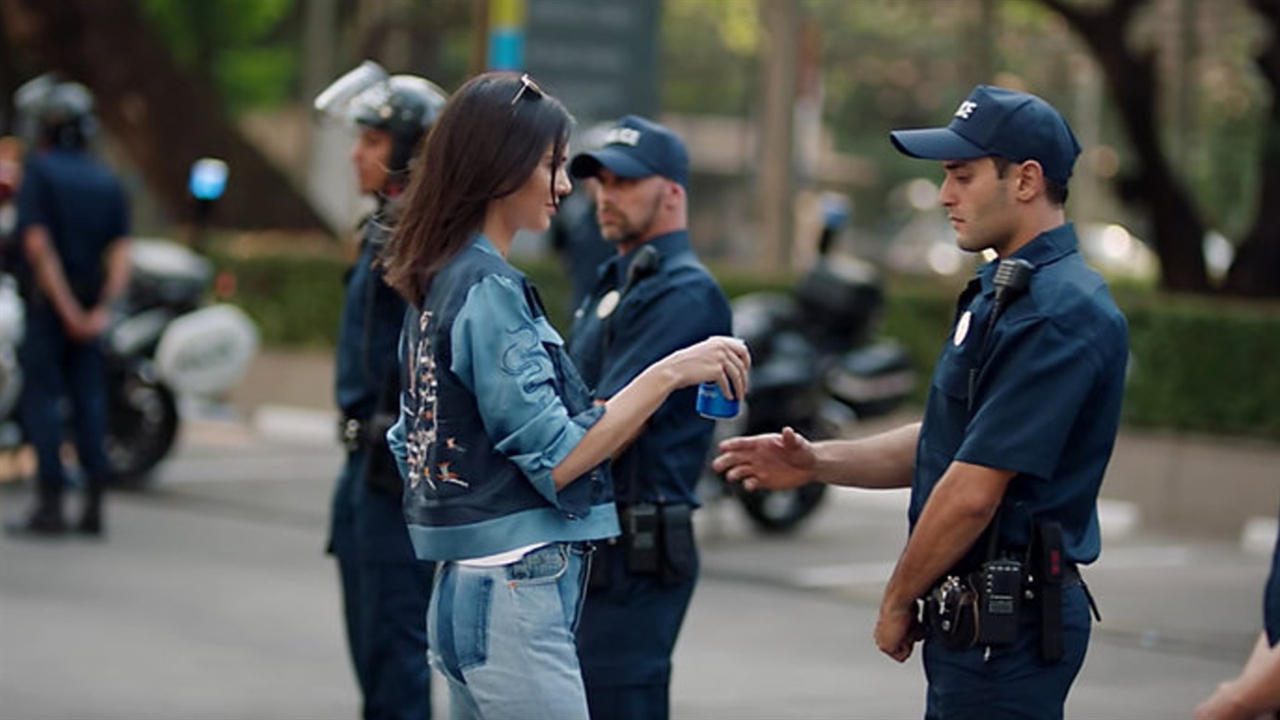
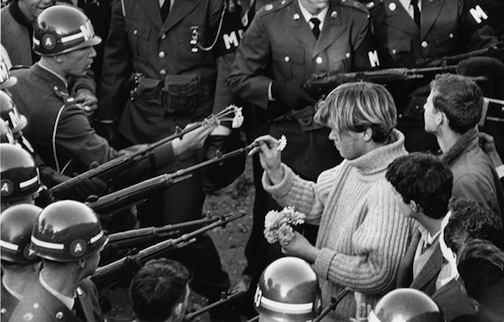
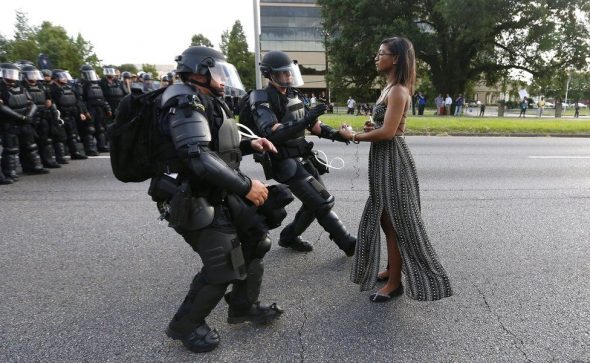
Thanks @Ben Adams!
It is folk like you that keep this conversation going.
I love this bit, “if you just want a bunch of young pretty people doing crazy stuff, it’s called a flash mob, and you don’t make signs for those, and the police don’t generally get involved. Ditto farmers markets, street fairs, and fun runs.
More to the point, whatever it is they are protesting must be controversial in some way — if you have a bunch of people walking down a city street for a cause that everyone can agree on, it’s called a parade.”
And your reaffirmation, “Right or wrong, protests (a) take organization and (b) have an actual political agenda. People don’t just wake up one day and start dancing in the street with signs! Most street protests are organized weeks or months in advance, with permits, buses, signs, equipment, and grassroots organizers.”
My initial recoiling to the outrage on behalf of Black Lives Matter was, “Well, Black Lives Matter did not invent protesting, and this commercial is so benign that it does not draw specific connections to Black Lives Matter, and there have been a whole bunch of recent protests (anti-trump, free speech, women’s march, airports, etc) recently that had nothing to do with Black lives matter, and there is a whole history of political protests like in the 60s with anti-Vietnam and such that for Black Lives Matter to claim “appropriation” seems misplaced.”
Thanks Ben Adams for acknowledging my concerns and issues with everything I just said, and still showing that the commercial is patently bad. I have nothing to object to in your critique, as it all feels really on point. So big thanks!
I also think you hit the nail on the head regarding the messaging that Pepsi was putting out their with this quote, “This commercial takes all of that effort and boils it down to: ‘Protests are a great way for the kids to unwind and break dance, but they don’t really mean anything. The protesters don’t even know what their protesting! Even if they did, all it takes to resolve our differences is to bond over our mutual love of attractive celebrities and consumer goods.'” When phrased in this way, it really seems like neo-liberal business people have learned how to troll the pop culture.
I am sure you don’t need a lesson in trolling, but I am going to give my take on it. Trolling is the Joker of culture. You look at something from a nihilistic perspective and manipulate it to the extreme before recreating it for cynical and narcissistic ends. Pepsi is the Joker of soft drinks. It’s like they are saying, “You know this thing that you love and use to express your feelings and opinion. Well, now I have a hold of it, I’m gonna shred it to pieces and reconstruct it to show you how foolish and silly you look to us from way up here on our piles of money. And you know what else, even after we corrupt and destroy this important and constitutionally protected freedom you enjoy, we are still gonna make piles of money because all the people who voted for the president agree with us that you all are ridiculous.”
It really makes Pepsi seem pretty awful. I am sure that their motives were not nearly as sinister or contrived as I just said, but it makes you think.
While the Baton Rouge protest is the most obvious parallel, I also noticed the evocation of the flowers in a gun barrel when I first saw it. Of the several podcasts I’ve listened to, the most outraged has been based on the subliminal stereotyping in what is ostensibly as progressive tableaux. An Asian guy plays a stringed instrument. The street dancers are African-American. Even the graphic artist/photographer is wearing what is arguably culturally traditional clothing for no apparent reason. It’s offensive by just trying to be inclusive.
I am reminded of the Super Bowl beer commercials with pro-immigration messages and I wondering if Pepsi was inspired by those, but then chickened out.
Maybe the first draft was specific about the protest target, but an executive nixed the idea in favor or a non-specific protest to appeal to everyone. That said, handing the officer a Pepsi was probably in every draft and it was a mistake every time.
Its an insulting solution to a real problem.
To be honest, the rest of us are just nibbling at the edges of the amazing work SNL has already done at deconstructing this genre of commercials.
SNL on the Pepsi ad: https://www.youtube.com/watch?v=Pn8pwoNWseM
SNL on political ads generally: https://www.youtube.com/watch?v=imUigBNF-TE
HARD CUT: Cheetos.
@Ben Adams, I am sure SNL did a great job, but I live in Taiwan, and SNL videos are not able to be seen here. Could you give a basic rundown?
Also, to my fellow readers/commenters, are SNL videos blocked in other countries too, or just here?
FYI you can take any youtube address and replace ‘tube’ with ‘pak’ to get around geo restrictions:
http://www.youpak.com/watch?v=Pn8pwoNWseM
Thoughts on a politically-charged but less-backlash-inducing Heineken ad? http://people.com/food/heineken-worlds-apart-ad-kendall-jenner-pepsi-commercial/
In my opinion it is really easy to fight against a group. What I mean by group is a categorization in your mind of people who fit a certain description. It is really easy to generalize about people based on their skin, their hair, their religion, their sex/gender/lack-thereof, their political party, their beliefs about abortion, or gay rights, or feminism, or toxic masculinity. It is really easy to take an opinion and generalize/make-up other characteristics about people who hold that opinion. Sam Harris said something to the effect of knowing a persons opinion about one issue should tell me nothing about their opinion of another issue. How you feel about guns should tell me nothing about how you feel about abortion.
Because I believe people hold diverse opinions within categories (all white people do not feel the same, all black people do not feel the same, all Republicans do not feel the same, all Democrats do not feel the same, etc), people should be approached as individuals and should be engaged in dialogue. Conversation is the only way to move forward.
This ad seems to epitomize my opinion about dialogue. We can disagree, but we can still learn. A conversation/argument should not be entered into in order to convince people that you are right and they were wrong. A conversation/argument should be put forward in order to best express your feelings, and to try to listen to the feelings/opinion/history/facts of the other side in order to learn. I don’t argue because I am right, but because I am in the process of learning, and I want to share what I know as well as gather more information to have a more informed opinion.
The ad is great. I love it. If you (or anyone out there on the interwebs) can explain to me why conversation/argument is not productive or valuable or necessary for learning, or if learning is even a valuable pursuit then please let me know.
PS. as an aside, did you see the videos of people at a riot between left and right trying to hand out pepsi’s to calm the tensions. I could not help but laugh. That is some next level trolling skills!
These are the type of ads that would make Paul Verhoeven cringe.
We’re already living in a weird corporate fascist dystopia.